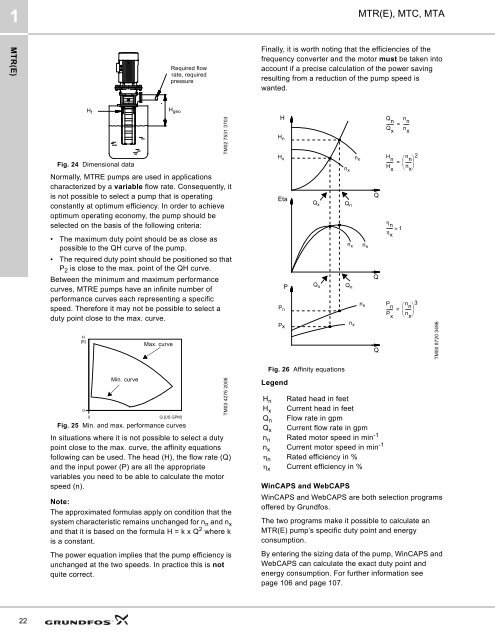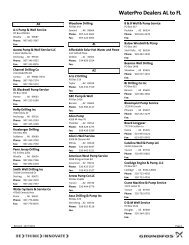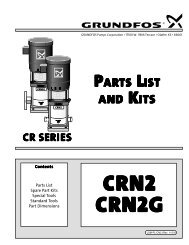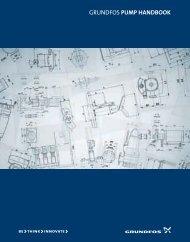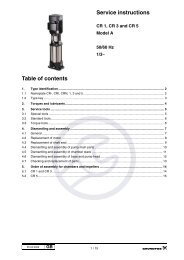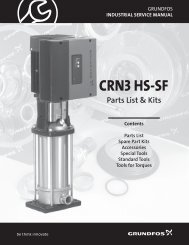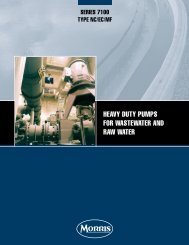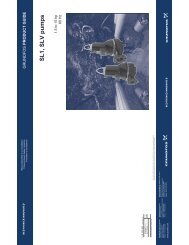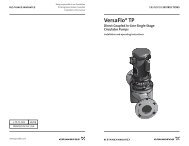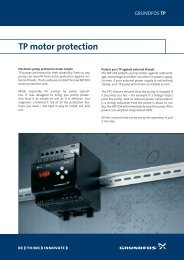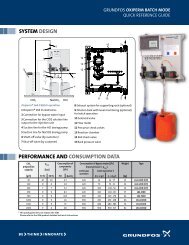MTR(E), MTC, MTA - Grundfos
MTR(E), MTC, MTA - Grundfos
MTR(E), MTC, MTA - Grundfos
You also want an ePaper? Increase the reach of your titles
YUMPU automatically turns print PDFs into web optimized ePapers that Google loves.
1<br />
<strong>MTR</strong>(E)<br />
22<br />
Hf<br />
Fig. 24 Dimensional data<br />
H geo<br />
Normally, <strong>MTR</strong>E pumps are used in applications<br />
characterized by a variable flow rate. Consequently, it<br />
is not possible to select a pump that is operating<br />
constantly at optimum efficiency. In order to achieve<br />
optimum operating economy, the pump should be<br />
selected on the basis of the following criteria:<br />
• The maximum duty point should be as close as<br />
possible to the QH curve of the pump.<br />
• The required duty point should be positioned so that<br />
P2 is close to the max. point of the QH curve.<br />
Between the minimum and maximum performance<br />
curves, <strong>MTR</strong>E pumps have an infinite number of<br />
performance curves each representing a specific<br />
speed. Therefore it may not be possible to select a<br />
duty point close to the max. curve.<br />
H<br />
[ft]<br />
0<br />
Min. curve<br />
Max. curve<br />
0 Q [US GPM]<br />
Fig. 25 Min. and max. performance curves<br />
Required flow<br />
rate, required<br />
pressure<br />
In situations where it is not possible to select a duty<br />
point close to the max. curve, the affinity equations<br />
following can be used. The head (H), the flow rate (Q)<br />
and the input power (P) are all the appropriate<br />
variables you need to be able to calculate the motor<br />
speed (n).<br />
Note:<br />
The approximated formulas apply on condition that the<br />
system characteristic remains unchanged for n n and n x<br />
and that it is based on the formula H = k x Q 2 where k<br />
is a constant.<br />
The power equation implies that the pump efficiency is<br />
unchanged at the two speeds. In practice this is not<br />
quite correct.<br />
TM02 7531 3703<br />
TM03 4276 2006<br />
<strong>MTR</strong>(E), <strong>MTC</strong>, <strong>MTA</strong><br />
Finally, it is worth noting that the efficiencies of the<br />
frequency converter and the motor must be taken into<br />
account if a precise calculation of the power saving<br />
resulting from a reduction of the pump speed is<br />
wanted.<br />
Fig. 26 Affinity equations<br />
Legend<br />
Hn Hx Qn Qx nn nx �n �x H<br />
H n<br />
H x<br />
Eta<br />
P n<br />
Px<br />
P<br />
Q x<br />
Q x<br />
n x<br />
Rated head in feet<br />
Current head in feet<br />
Flow rate in gpm<br />
Current flow rate in gpm<br />
Rated motor speed in min-1 Current motor speed in min-1 Rated efficiency in %<br />
Current efficiency in %<br />
WinCAPS and WebCAPS<br />
WinCAPS and WebCAPS are both selection programs<br />
offered by <strong>Grundfos</strong>.<br />
The two programs make it possible to calculate an<br />
<strong>MTR</strong>(E) pump’s specific duty point and energy<br />
consumption.<br />
Q n<br />
n x<br />
Q n<br />
n x<br />
By entering the sizing data of the pump, WinCAPS and<br />
WebCAPS can calculate the exact duty point and<br />
energy consumption. For further information see<br />
page 106 and page 107.<br />
n n<br />
n n<br />
n n<br />
Q<br />
Q<br />
Q<br />
Q<br />
n<br />
n<br />
n<br />
------- = ------<br />
Q<br />
x<br />
n<br />
x<br />
H<br />
n �n n�<br />
------- �------ �<br />
H n<br />
x � x�<br />
2<br />
=<br />
�<br />
n<br />
------ � 1<br />
�<br />
x<br />
P<br />
n �n n�<br />
------ �------ �<br />
P n<br />
x � x�<br />
3<br />
=<br />
TM00 8720 3496


